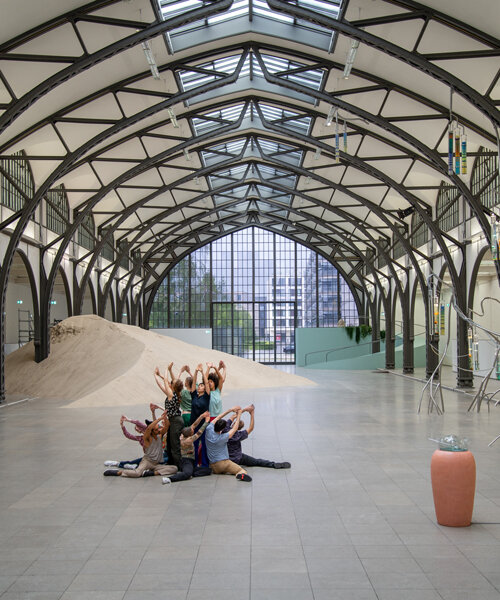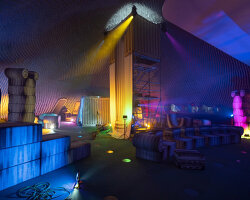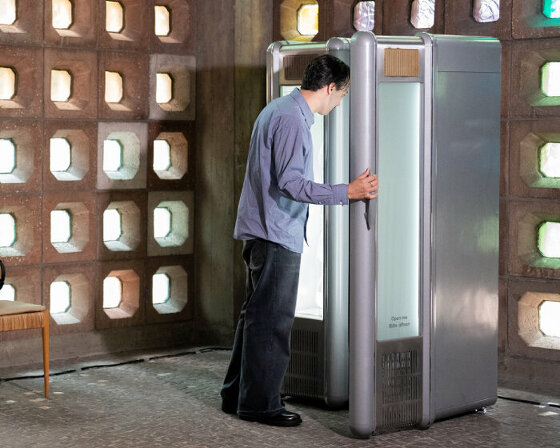ATTUNE: LARGE-SCALE SITE-SPECIFIC INSTALLATION by ALEXANDRA PIRICI
Artist and choreographer Alexandra Pirici presents ‘Attune,’ a new large-scale site-specific installation with live performative action in the Historic Hall of Hamburger Bahnhof in Berlin. Co-commissioned by Hamburger Bahnhof – Nationalgalerie der Gegenwart and Audermars Piguet Contemporary, and co-funded by the German Federal Cultural Foundation, the immersive installation transforms the hall into a vibrant living landscape. The exhibition will be on view from April 25th to October 6th, 2024.
Pirici’s action installation arranges a group of human performers who interact, move, dance, and sing within a landscape of animate and inanimate sculptural configurations highlighting the intelligence and performativity of self-structuring matter. A large sand dune repeatedly reconstructs itself as dancers’ bodies merge with its particles through subtle or, at times, more eminent gestures. Glass containers suspend from a stainless steel vine-like sculpture, serving as everchanging plants evolving through time. These active sculptural elements, featuring mineral formations and chemical gardens, remodel, prompted by the live performative action and polyphonic musical pieces occurring in space.
The ongoing active composition showcases a continuum of self-organizing processes and patterns. With ‘Attune,’ Alexandra Pirici explores the ways in which humans and non-humans resemble, influence, and attune to one another. The work encourages viewers to recognize and appreciate the interconnectedness of organic and inorganic forms within the world around us.

all images courtesy of the artist, Hamburger Bahnhof and Audemars Piguet
performative process celebrates Human and Non-Human Synergy
Pirici creates a dynamic imaginary landscape in the Historic Hall of Hamburger Bahnhof, combining active sculptural elements with live performance and intricate musical compositions. This setting, designed in collaboration with long-term partner Andrei Dinu, merges the archaic and the futuristic. Chemical reactions, mineral formations, and physical phenomena perform alongside living bodies in acknowledgment and celebration of the similarities, influences, and harmonies between humans and non-humans. ‘These processes not only define the experiential world, but also offer an insight into the emergence of life and evolution,’ Alexandra Pirici tells designboom.
‘Attune’ marks Pirici’s second partnership with Audemars Piguet Contemporary, building on the program’s backing of Pirici’s Encyclopedia of Relations (2022) at the 59th Venice Biennale. This new co-commission allows the artist to expand her work on a grander scale, blending fixed physical structures with live performance. The performative installation is curated by Catherine Nichols, curator at Hamburger Bahnhof – Nationalgalerie der Gegenwart, and is a joint commission between Hamburger Bahnhof and Audemars Piguet Contemporary. The exhibition is accompanied by the fifth installment of Hamburger Bahnhof’s catalogue series, published by Silvana Editoriale Milano. The exhibition receives financial support from the Kulturstiftung des Bundes (German Federal Cultural Foundation) and Die Beauftragte der Bundesregierung für Kultur und Medien (Federal Government Commissioner for Culture and the Media).

Alexandra Pirici presents ‘Attune,’ a site-specific installation with live performance in Berlin’s Hamburger Bahnhof
interview: ‘Attune’ through Alexandra Pirici’s words
designboom (DB): can you please start by introducing us to the concept behind ‘Attune?’
Alexandra Pirici (AP): The main idea revolves around the process of self-organization in both living and non-living matter. This process, like morphogenesis in embryos for example, involves cells organizing themselves to form specific structures. Benign compaction in heated liquids also displays this process. I was fascinated by how this procedure, basically, spans all these forms of matter, and by the idea that non-living matter nevertheless has the capacity to act and to produce, to construct something on its own, and the implication of this realization. For me, it was inspiring to investigate these interactions and try to stage them and find different instances of these self-organizing processes that I could embody with performers, and just show in different elements in the space.

‘Attune’ sets up a living landscape, combining performance art with animate and inanimate configurations
DB: what is the role of the visitors’ interaction in the performance?
AP: I didn’t aim for a didactic approach. Instead, I see the exhibition as a landscape visitors could explore freely. The live-action performance invites visitors to move through the space, discovering different interactive elements. Some bodies, such as the tree-like organ, are chemically driven, the performers activate them, allowing visitors to witness these chemical reactions. But I think it’s mostly just about observing these structures that are self-emerging in this way.
The sand dune is also an example of a self-organizing structure, as well as most or a lot of the things that the performers do. Certain actions are inspired by dynamic structures in groups of birds and starlings, more specifically. The singing is also about celebrating or creating a kind of ceremonial situation around this landscape. I think it’s just important that visitors enjoy it and that they take something or maybe they become curious about something and interested in the landscape itself.

performers interact, dance, and sing in a dynamic landscape, merging with the sculptural elements
DB: What is the role of sound in your work?
AP: I have actually always worked with music, most of the time live music. I am just interested in using the human voice. So in this context, polyphonic singing takes center stage, enhancing the experience. I think sound is also that element that takes up space in the best way traveling in it and filling up the entire hall. Here, polyphonic singing acts as this merger of more melodic lines into one common harmony which is something difficult to achieve. This challenges both the performers and the audience.
But, then, besides the artistic value, I think there’s an interesting political value in it. I don’t think we are practicing the capacity to listen to different voices at the same time and to find a common harmony or to find a common ground and find something that still sounds melodic. So in this particular work, which is called ‘Attune,’ we are talking also a lot about attuning and listening to each other, maybe your voice here has to be lower and maybe another one has to be higher, and the performers do a really beautiful work in finding this balance and listening to each other. I think this is the most important musical aspect of this specific work.

the large sand dune repeatedly shifts and reconstructs itself as dancers integrate with its form
DB: you mentioned that there are political aspects in your work, mostly through polyphonic singing and the symbiosis of living and non-living structures, could you elaborate on that?
AP: Polyphony presents a clear physical challenge of both producing and blending different melodic lines while maintaining harmony. This mirrors a political exercise, in the sense of harmonizing distinct voices singing different tunes. I’m interested in politics that aren’t always explicit but are present in the work, in the way the performers interact, and in the overall experience. The continuum between living and non-living matter is politically interesting, tying into the story of the world as an interconnected fabric, offering a liberating and politically significant perspective on transformation and change.

the installation showcases a continuum of self-organizing processes and patterns

Pirici explores the connections between humans and non-humans, emphasizing their similarities

the live performative action, combined with polyphonic musical pieces, creates a captivating experience

the installation includes active sculptural elements such as a stainless steel vine-like sculpture, a chemical garden

the installation showcases a continuum of self-organizing processes and patterns

the exhibition encourages viewers to recognize the interplay between organic and inorganic forms





project info:
name: Attune
artist: Alexandra Pirici | @alexandrapirici
co-commission: Hamburger Bahnhof – Nationalgalerie der Gegenwart | @hamburger_bahnhof
co-commission: Audemars Piguet Contemporary | @audemarspiguet
curator – Hamburger Bahnhof – Nationalgalerie der Gegenwart: Catherine Nichols
curator – Audemars Piguet Contemporary: Denis Pernet
performers: Caroline Beach, Juan Corres Benito, Noemi Calzavara, Michelle Cheung, Gabrielle Duval, Miguel Angel Guzmán, Nitsan Margaliot, Jared Marks, Tatiana Mejía, Emily Ranford, Asuka Julia Riedl, Robert Schulz, Yurika S. Yamamoto
dates: April 25th to October 6th, 2024
architecture in berlin (78)
audemars piguet (22)
exhibition design (594)
interactive installation (261)
PRODUCT LIBRARY
a diverse digital database that acts as a valuable guide in gaining insight and information about a product directly from the manufacturer, and serves as a rich reference point in developing a project or scheme.




















